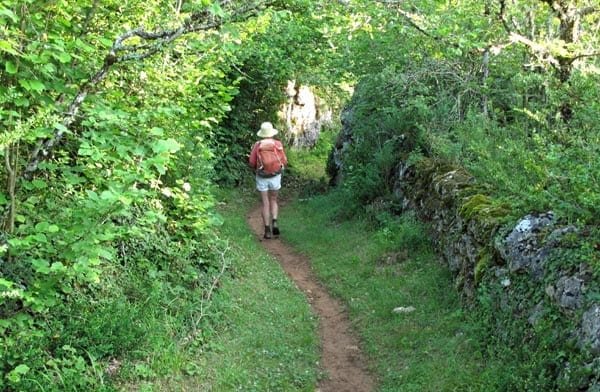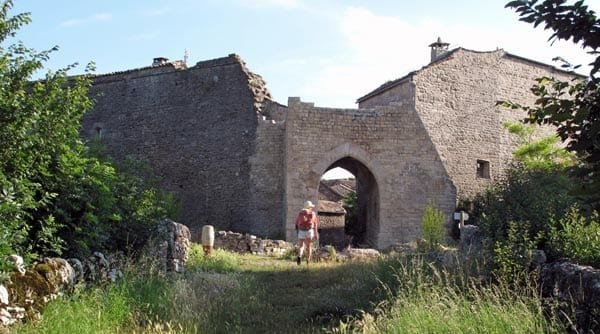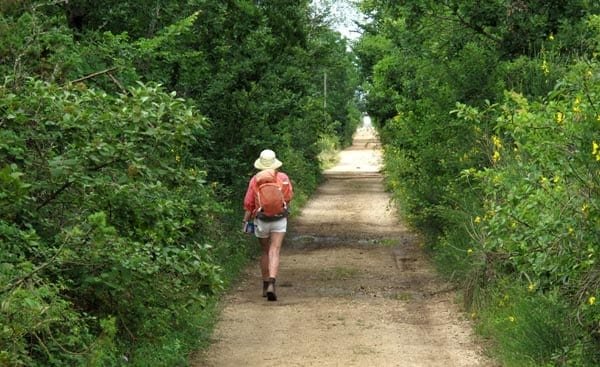
Tuesday, 10 July 2012
Distance 23 km
Duration 4 hours 55 minutes
Ascent 271 m, descent 275 m
Map 162 of the TOP 100 lime-green series
We had left our walking clothes on the washing line overnight as they were not quite dry when we came back from dinner, and they were in the same state in the morning, so putting them on was rather a cool and clammy experience.
Leaving our packs hidden under a bush near the big boulder, we stepped out onto the GR and retraced our steps, although it went against the grain to set off in the wrong direction.

On the way we noticed for the first time the ruined fortress on the hill behind the village, lit by the first rays of the sun.

We got to the boulangerie at about 7 am and it was in full swing, with local people coming and going to the brightly lit counter and groups of truck drivers having breakfast.

It was a delightful novelty for us to have coffee and pastries so early in the day, well worth the back-tracking.
Well fortified, we returned to the camping ground and picked up our bags from their hiding place, then started off on our day’s walk.

It was like a garden for the first hour. The path, bordered by grass and flowers, wound its way through the rocks and trees beside an ancient mossy wall, no doubt delineating the main thoroughfare between the villages of le Caylar and la Couvertoirade.
Translucent green light sifted down through the leaves, but further on we emerged onto a dry, shadeless hillside covered with hardy shrubs.


At the top of the rise we caught sight of la Couvertoirade, a tight jumble of roofs and towers enclosed by a pale grey wall.
It lay in a shallow depression, with a windmill on the hill nearby. It was tiny but we knew it was a Plus Beau Village and would be worth a visit.


As it turned out, it was a bit of a disappointment. The place had been entirely given over to tourism, and 9 o’clock was too early for the tourists, so it looked like a film set before the arrival of the crew.
Even the half-ruined towers and walls looked fake. We would not have been surprised to learn that the whole thing had been constructed within the last few years (in fact, the south portal where we had entered was newly rebuilt, having collapsed in 1912).

From the signs we could see that almost every house had become a purveyor of souvenirs or refreshments.
There was not a soul to be seen and we needed to find water. We wandered out of the main gate and saw a delivery van, whose driver suggested that we try the public toilets where there was a handbasin.

So in this unsalubrious way we refilled our water bottles and left the village without regret. From la Couvertoirade, there were GRs going in all directions and we hoped that we were on the right one.
At an intersection of roads, none of the places mentioned on the signposts seemed to appear on our map, but finally, we noticed ”Chambres d’hôte de la Salvetat”, pointing along one of the roads, and la Salvetat was marked on the map, in the right direction, so we went that way.
After a short distance, the GR branched off onto a pleasant wheel track which curved around between a wheat field and a rocky ridge, then branched again, intersected a dirt road and crossed more fields before finally joining the bitumen at the entry to la Salvetat.


The village was no more than a few houses scattered around a fork in the road. A man and woman nursing coffee mugs in their garden greeted us as we trudged by, and that was more people than we had seen in all of the tourist trap of la Couvertoirade.
The GR continued along the same wheel track towards la Blaquererie, but we had seen a short cut on the map – a tiny road going straight to the same destination in half the distance. We set off, but soon found out that what we saved in distance, we lost in altitude. Or gained, strictly speaking.
The road shot uncompromisingly up the slope without a slant or a bend. It was hardly wider than a footpath and about as much frequented by cars.

We puffed up to the top, which was not as high as it looked, and down the other side, where the picturesque village of la Blaquererie lay amongst hedges and gardens.
Having confirmed our fear that there was no bar in the village, we rejoined the GR as it went on its way.
As soon as we were out of sight of the houses, we sat down beside the track and had a little morning refreshment of bread, sausage, cheese and cucumber. It was 11:30 and there would clearly be no coffee forthcoming on this day’s march.

Nevertheless, the walk was a delight. The path twisted gracefully over a slight elevation in the causse, amongst young pines rooted in what looked like pure broken-up rock.

As we came down we entered an oak wood and heard voices. In a clearing was a square white tent, as big as a suburban house, and washing hanging on a fence.

There were people cutting wood and bending over vegetable beds, with whom we exchanged friendly waves.
Several old cars were parked on the rough ground, but how they had got there was a mystery until the track suddenly became a dirt road and curved away up a steep incline. The GR did not follow, instead sidling across a scree slope under the trees and emerging onto another piece of road.
This road was much flatter and straighter, and after a while it went through a deep cleft in the rock. We noticed the scars of blasting on the walls and realised that we were not in a natural landscape, but on an abandoned railway line.
This was a surprise, but a pleasant one, as there were embankments and bridges keeping us on the level.
Then the ground became muddy and we had to negotiate a series of puddles stretching right across the road, difficult to get around.

A car containing a man and a child crawled past in the opposite direction, perhaps going to the tent commune.
At length we spied, at the end of a long tunnel of greenery, a floating white strip which we hoped was the bridge of the autoroute. It was, but it took a long time to get to. The GR turned off towards the village before we arrived at this bridge, but we kept going.
Even after we had crossed under the autoroute, we had another kilometre or so to walk before we saw the camping ground, which was on the corner of the old highway.

To our tired eyes it was a beautiful sight with its sweeping lawns of impossible smoothness and its lines of mature chestnuts and conifers, under which caravans were lined up.
The entrance gates opened onto a fine looking house with deep eaves and many-paned windows. The gravel terrace in front had tables and chairs shaded by an arc of chestnut trees.
Inside there was a large bar and dining room, and a man emerged from the back, wiping his mouth on a napkin, and took our €12, waving vaguely towards the lawns with the invitation to camp wherever we liked.
We chose a bright, open patch of grass, a mixture of sun and shade, as it was a bit cool once we stopped walking (we were now at 800 m elevation).

Then, for the first time in many days, we had lunch. We had bread from Lodève, tomato and cucumber from Grabels, mayonnaise from Montarnaud and salami from lord knows where; and enjoyed it very much.
After that we retired to the ablutions block and washed ourselves and almost all our garments. Keith washed his long pants for the first and last time, and I washed both my shirts in succession, putting on the almost-dry red one in order to wash the grimy white one. My red shirt, which I washed every day, was getting paler and paler.

We slept the sleep of the just for an hour or so and then went back to the bar for coffee. Our last coffee had been at le Caylar, before we set off, so this one was very welcome.
We asked whether there was anywhere to eat in l’Hospitalet in the evening and our host replied that there was nothing at any time of day, but that he could provide an omelette and chips, which offer we gratefully accepted.
There were local people at some of the other tables, and we found out later that this was the nearest thing to a village bar in l’Hospitalet.
Several more caravans drove in, and then two women arrived on foot, one of them harnessed to a strange two-wheeled cart loaded with gear. They were directed down to a cottage beyond our tent, which they had evidently booked in advance.

Later a red van appeared and the driver offered us a case of apricots. When I said we wanted two, he brightened, but on finding that I meant two apricots, not two cases, he drove off in disgust.
At 7:30 we were at the bar again, this time indoors, as it had become cold. We ordered our usual apéritifs (a glass of rosé for me and a pastis for Keith) and drank them in a corner next to an industrial-size wood heater, which would certainly be needed for most of the year. There were splendid old armchairs, a coffee table and on the wall a fascinating relief map of the district.
The two women walkers came in and sat at the dining table, whereupon our host invited us to do the same. They turned out very agreeable and it was a good French lesson. One of them was from Tours and the other from near Paris, and they were on a two-week circular walk across the plateau of the Larzac.

Their car was in le Caylar, so they were nearly finished, although they would take two more days, staying at la Couvertoirade tomorrow night. Both of them swore that their little, small-wheeled cart could manage rough tracks as well as roads, but it was hard to imagine.
As is the way among walkers, we compared notes about our equipment. They carried four changes of clothes, whereas we had only two, and they did not have camping gear. They were not sure how much weight they had – with wheels it was not as important.
We had a delightful meal of melon and ham, followed by an omelette with chips, bread and salad. For dessert, our host brought out a dish of apricots, no doubt from the red van of the afternoon, so we took two for our breakfast.
Previous day: Lodève to le Caylar